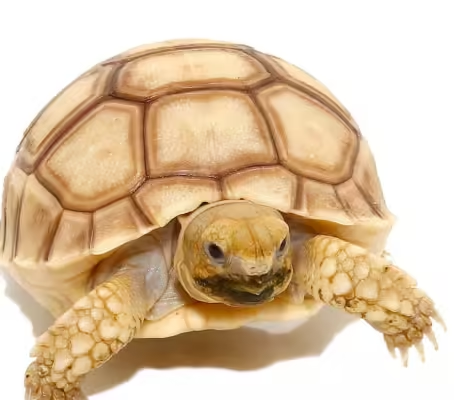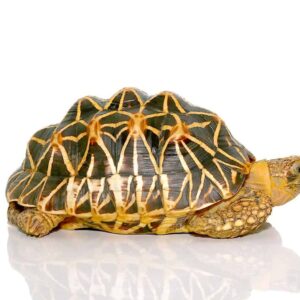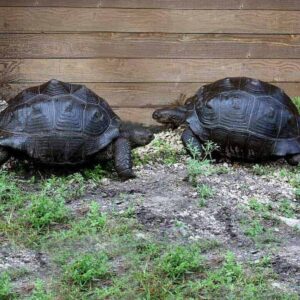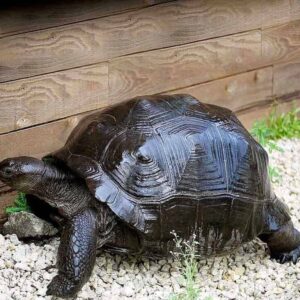Baby Hypo Sulcata Tortoise For Sale
$999.99
WE HAVE Baby Hypo Sulcata Tortoise FOR SALE. HERE ARE SOME HIGHLIGHTS:
- Centrochelys sulcata
- Farm Bred
- Around 3 Inches In Shell Length
- Adults Can Reach Up To 36 Inches In Shell Length
- Feasting On Vitamin Dusted Fresh Greens, Hays, And Tortoise Diet
FUN FACTS!!
- Tortoises Are Very Personable And Make Great Pets
- Hypo Is A Morph That Makes This Tortoise Much Lighter And Brighter In Color
- Originating From The Sub-Saharan Regions Of Africa
- With Proper Care And A Well Maintained Diet These Can Live Up To 100 Years At A Time
- These Tortoises Come From The Dry Grasslands Of Africa Thriving Best In Those Conditions
- They Are Also Known As “Spur Thighs” Which Comes From The Elongated Scales On Their Front Legs That They Use To Dig And Push Dirt Out Of Their Burrows
Description
Baby hypo Sulcata tortoises, scientifically known as Centrochelys sulcata, are a unique and captivating variant of the standard Sulcata tortoise. Originating from the arid regions of the Sahara Desert in Africa, these reptiles are known for their remarkable adaptability to harsh environments. The hypo variant, short for hypomelanistic, is distinguished by its lighter and more vibrant coloration compared to the typical Sulcata tortoise. This unique trait results from a genetic mutation that reduces the pigment melanin, giving the hypo Sulcata its striking appearance.
In their natural habitat, Sulcata tortoises thrive in dry, hot climates where they burrow underground to escape extreme temperatures. These burrows can extend several feet and provide essential shelter and humidity. Despite their origins in such challenging environments, Sulcata tortoises have become popular pets worldwide. Their hypo counterparts, with their eye-catching colors and patterns, have garnered significant attention among reptile enthusiasts and collectors.
The popularity of baby hypo Sulcata tortoises as pets can be attributed to several factors. Firstly, their unique appearance makes them highly desirable. Secondly, they exhibit a relatively gentle temperament and can form strong bonds with their owners. Additionally, their herbivorous diet, primarily consisting of grasses and leafy greens, is relatively easy to manage. However, it is crucial for prospective owners to be aware of their long-term commitment, as Sulcatas can live for several decades and grow to a substantial size.
Understanding the origins and characteristics of baby hypo Sulcata tortoises provides a solid foundation for anyone considering adding these fascinating creatures to their home. Their distinct features and engaging personalities make them a unique and rewarding choice for dedicated reptile enthusiasts.
Physical Characteristics
Baby hypo Sulcata tortoises, also known as hypo African spurred tortoises, are a distinctive and captivating variant of the Sulcata species. One of the most noteworthy aspects of these tortoises is their size. At birth, baby hypo Sulcata tortoises typically measure about 1.5 to 2 inches in length. They grow rapidly during their first few years, eventually reaching adult sizes that can range between 24 to 30 inches in length, making them one of the largest tortoise species.
The hypo Sulcata tortoise is celebrated for its unique shell color and patterns. Unlike the standard Sulcata tortoises, which possess a tan or brown shell, the hypo variant exhibits a lighter, more visually striking shell. Their shells often feature hues of yellow, cream, and light brown, creating a visually appealing contrast. The scutes, or individual plates on their shells, are usually marked with intricate patterns, adding to their distinctive appearance. These color variations are a result of selective breeding aimed at enhancing their aesthetic appeal.
Another notable physical trait of baby hypo Sulcata tortoises is their distinctive skin color. While standard Sulcatas possess darker skin tones, the hypo variety tends to have lighter skin, often appearing in shades of pale yellow or light brown. This lighter skin color complements their shell, further distinguishing them from their counterparts.
Compared to other tortoise species, baby hypo Sulcata tortoises are relatively easy to identify due to their size, shell color, and patterns. For instance, the Leopard tortoise, another popular species, has a more rounded shell with distinctive black and yellow markings, differing significantly from the hypo Sulcata’s lighter and more uniform shell coloration. Similarly, the Red-footed tortoise, known for its vibrant red and orange markings on its limbs and head, contrasts sharply with the hypo Sulcata’s more subdued and uniform coloration.
In summary, the physical characteristics of baby hypo Sulcata tortoises make them a unique and visually appealing choice for tortoise enthusiasts. Their size, shell color, and patterns, along with their lighter skin tones, set them apart from other tortoise species, particularly other Sulcata variants.
Habitat and Enclosure Setup
Creating an ideal habitat for baby hypo Sulcata tortoises is crucial for their health and well-being. These tortoises thrive in environments that closely mimic their natural habitat. Selecting the right enclosure is the first step. A spacious enclosure, at least 2 feet by 4 feet, is recommended for baby hypo Sulcata tortoises, allowing them ample space to explore and grow. Glass terrariums or wooden tortoise tables are suitable options, as they provide both visibility and ventilation.
The choice of substrate is equally important. A mix of coconut coir, organic topsoil, and play sand can create a comfortable and burrow-friendly base. This combination helps maintain appropriate humidity levels and allows the tortoises to engage in their natural digging behavior. Avoid substrates like pine or cedar shavings, as these can be harmful to the tortoises.
Temperature regulation is essential in the habitat setup. Baby hypo Sulcata tortoises require a temperature gradient within their enclosure, with a basking spot maintained at 95 to 100 degrees Fahrenheit and a cooler area around 75 to 85 degrees Fahrenheit. Using a combination of heat lamps and ceramic heat emitters can achieve this gradient. Additionally, UVB lighting is critical for their shell and bone development, so ensure they receive 10 to 12 hours of UVB exposure daily.
Humidity levels should be monitored closely, as baby hypo Sulcata tortoises require moderate humidity. Aim to keep the humidity around 40 to 60 percent. This can be achieved by misting the enclosure regularly and providing a humid hide, which can be as simple as a dampened moss-filled hide box.
Accessorizing the enclosure with essential items enhances the habitat. Provide hides for security, basking spots for thermoregulation, and shallow water dishes for drinking and soaking. These elements replicate their natural environment and promote healthy behaviors. By carefully curating the habitat and enclosure setup, you ensure that baby hypo Sulcata tortoises grow up in a safe, comfortable, and stimulating environment.
Diet and Nutrition
Ensuring a proper diet is crucial for the healthy growth and development of baby hypo Sulcata tortoises. These tortoises require a diet rich in fiber and low in protein and sugars. A well-balanced diet primarily consists of various greens and vegetables, with occasional fruits in moderation.
Suitable greens for baby hypo Sulcata tortoises include collard greens, mustard greens, dandelion greens, and turnip greens. These greens are high in essential nutrients and provide the necessary fiber content. Vegetables such as squash, bell peppers, and carrots can also be included in their diet, but should be fed in moderation to avoid excessive sugar intake.
Occasional fruits can be offered as treats but should not constitute more than 10% of their overall diet. Fruits like strawberries, melons, and apples can be given sparingly. Overfeeding fruits can lead to health issues due to their high sugar content.
Calcium is vital for the development of strong bones and shells in baby hypo Sulcata tortoises. Calcium supplements should be dusted over their food a few times a week. Additionally, providing a cuttlebone in their enclosure allows them to self-regulate their calcium intake. Vitamin D3 supplements are also recommended, especially for tortoises that do not have regular access to natural sunlight, as it aids in calcium absorption.
Maintaining a balanced diet is not just about the right food choices, but also involves avoiding common dietary pitfalls. Overfeeding high-protein foods such as animal products or legumes can lead to kidney damage and other health issues. Similarly, iceberg lettuce and other low-nutrient foods should be avoided as they do not provide the necessary nutrients and can cause digestive problems.
In summary, the diet and nutrition of baby hypo Sulcata tortoises should focus on a variety of greens, vegetables, and occasional fruits, supplemented with calcium and vitamin D3. Avoiding high-protein and low-nutrient foods is essential to promote healthy growth and prevent dietary-related health issues.
Health and Wellness
Ensuring the health and wellness of your baby hypo Sulcata tortoise is paramount to fostering a long and thriving life. Common health issues that may arise include respiratory infections, shell rot, and metabolic bone disease. Respiratory infections often manifest as wheezing, nasal discharge, and lethargy. Shell rot is typically identified by discolored, soft, or foul-smelling areas on the shell. Metabolic bone disease is usually caused by improper diet and lack of UVB exposure, leading to softening of the bones and shell.
Recognizing the signs of illness early can significantly improve the outcomes for your tortoise. Sudden changes in appetite, abnormal feces, lethargy, and changes in behavior are all indicators that something might be amiss. Immediate consultation with a reptile-savvy veterinarian is crucial if any of these symptoms are observed. Regularly scheduled health checks are an excellent way to catch potential problems early. These checks should include monitoring the tortoise’s weight, inspecting the shell and skin for abnormalities, and observing feeding and defecation habits.
Preventive measures are essential in maintaining the overall health of baby hypo Sulcata tortoises. Providing a balanced diet rich in calcium and ensuring adequate UVB lighting are fundamental practices. Clean and appropriate habitat maintenance, including proper humidity and temperature levels, also plays a significant role in preventing health issues. Additionally, regular bathing can help with hydration and facilitate normal shedding of the skin and scutes.
Parasites, both internal and external, are another concern for tortoise owners. Routine fecal examinations by a veterinarian can help detect internal parasites early and allow for timely treatment. External parasites, such as mites or ticks, should be addressed promptly to prevent discomfort and disease transmission. Maintaining a clean habitat is a key preventive measure against parasite infestations.
Lastly, finding a qualified reptile-savvy veterinarian is invaluable. Not all veterinarians are experienced with tortoises, so it’s important to locate one who is knowledgeable about the specific needs of hypo Sulcata tortoises. Establishing a relationship with such a professional can provide peace of mind and ensure that your tortoise receives the best care possible.
Behavior and Temperament
When it comes to the behavior and temperament of baby hypo Sulcata tortoises, understanding their natural tendencies is key to ensuring a healthy and enriching environment for these unique reptiles. Generally, baby hypo Sulcata tortoises are known for their relatively high activity levels compared to other tortoise species. They are often seen exploring their surroundings, foraging for food, and basking in the sun. These tortoises exhibit a curious nature and can be quite engaging to observe.
In terms of social interactions, baby hypo Sulcata tortoises are primarily solitary creatures. While they may tolerate the presence of other tortoises, they do not form bonds or exhibit social behavior in the same manner as mammals. However, they can become accustomed to human interaction if handled gently and regularly. When handling your baby hypo Sulcata tortoise, it is crucial to support their body fully and avoid sudden movements, as these can cause stress or injury.
Unique behaviors to expect from baby hypo Sulcata tortoises include burrowing and digging. These activities are essential for their well-being as they help regulate their body temperature and provide a sense of security. To promote natural behaviors, providing a substrate that allows for digging and creating hiding spots within their enclosure can be beneficial. Additionally, offering a variety of plants and objects for them to explore can enrich their environment and stimulate their natural curiosity.
To further enhance their well-being, socialization and environmental enrichment are crucial. Gradual and consistent handling can help your baby hypo Sulcata tortoise become more comfortable with human interaction. Introducing safe and stimulating elements into their habitat, such as rocks, logs, and edible plants, can encourage natural exploration and foraging behaviors. By understanding and catering to the behavior and temperament of baby hypo Sulcata tortoises, you can create a nurturing environment that supports their physical and mental health.
Breeding and Growth
The breeding process of hypo Sulcata tortoises is a fascinating and intricate endeavor. Typically, the breeding season for these tortoises begins in the late summer and extends into the fall. During this period, it is essential to provide an environment that mimics their natural habitat, with appropriate temperatures and humidity levels to encourage mating behaviors. Male Sulcata tortoises are known for their assertive courtship rituals, which include circling and nudging the female.
Once mating has occurred, the female will lay her eggs in a carefully excavated nest. It is crucial to monitor the nesting site to ensure it remains undisturbed. The incubation of Sulcata tortoise eggs requires a controlled environment with a consistent temperature range between 82-86°F (28-30°C) and humidity levels around 80%. The incubation period generally lasts between 90 to 120 days, depending on the specific conditions maintained.
After hatching, the care of baby hypo Sulcata tortoises demands meticulous attention. Hatchlings are particularly vulnerable and require a warm, humid environment to thrive. It is essential to provide a shallow water dish for hydration and a diet rich in calcium and fiber to support their rapid growth. Regular monitoring of their health and development is vital during these early stages.
The growth rate of hypo Sulcata tortoises can vary, but they generally experience significant growth within their first few years of life. During this period, developmental milestones include the strengthening of their shells, increased mobility, and the gradual expansion of their size. To ensure healthy growth, it is important to provide a spacious habitat, a balanced diet, and regular exposure to UVB lighting, which is crucial for their bone development and overall health.
In summary, understanding the breeding and growth processes of hypo Sulcata tortoises is key to fostering their well-being. By maintaining optimal conditions for breeding, incubation, and early care, enthusiasts can support the healthy development of these remarkable reptiles, ensuring they thrive in both captivity and natural settings.
Legal and Ethical Considerations
When choosing to keep a baby hypo Sulcata tortoise as a pet, it is crucial to consider both the legal and ethical implications of such a decision. Ensuring that your pet is sourced legally and ethically is fundamental to supporting sustainable and humane practices. Potential owners should familiarize themselves with local, state, and federal regulations that govern the ownership of Sulcata tortoises. These regulations can vary significantly by jurisdiction, so it is essential to verify specific requirements, such as permits or licenses, before acquiring a tortoise.
One of the most important aspects of sourcing a baby hypo Sulcata tortoise is to ensure that it comes from a reputable breeder. Reputable breeders prioritize the health and well-being of their animals, provide appropriate care, and maintain ethical breeding practices. Avoid purchasing tortoises from unverified sources or individuals who may engage in unethical practices such as overbreeding or improper care. Supporting reputable breeders helps to prevent the exploitation of these animals and contributes to the overall well-being of the species.
In addition to legal considerations, potential owners should reflect on the long-term commitment required for caring for a Sulcata tortoise. These tortoises can live for several decades, with some reaching up to 70 years or more. Owning a Sulcata tortoise is a lifelong commitment that demands significant time, resources, and dedication. Proper housing, a specialized diet, and regular veterinary care are essential to ensure the health and longevity of these animals.
Ethical ownership also involves providing an environment that meets the tortoise’s physical and psychological needs. This includes adequate space for movement, appropriate temperature and humidity levels, and opportunities for natural behaviors such as burrowing and foraging. By considering these factors and making informed decisions, potential owners can ensure that they are acting responsibly and ethically in their care of baby hypo Sulcata tortoises.










